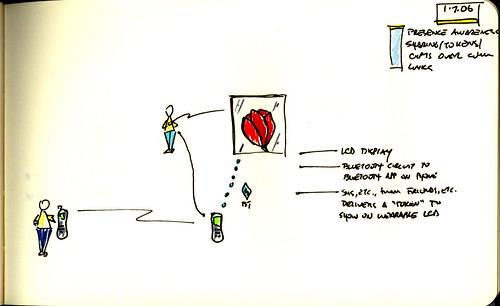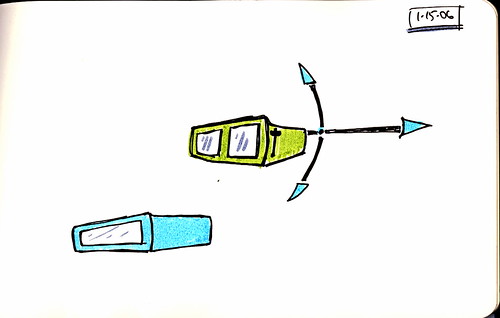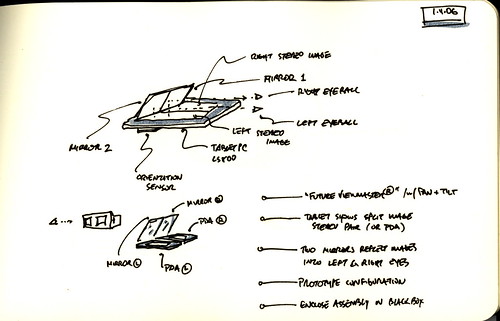I have always enjoyed Nicolas Nova‘s way of appending his posts with a framing statement describing why he blogged what he blogged, so I took up this Talmudic Why do I blog this? practice, but this post is about a higher order question: Why do I blog? or, more to the point, Why should design agents blog?
For me, it comes down to making things public in a way that is part an experiment in a kind of open-source design practice, part as a way to manage a torrent of ephemeral material, snippets, thoughts, sketches, cobbled together prototypes, Shandy-esque projects that start and then stop and then start and then divert — a collection and idea circulation machine. It’s a way to circulate thought within my modest network of thinkers, knowledge agents, dudes and doodlers and enroll them in the process of creating terribly evocative objects that move beyond what I could create on my own. Sometimes, I need to start them on my own — or carry them through to a point at which they begin circulating as theory objects, evocative knowledge objects, or prototypes that help get them off the bench. At some point, they become their own agents of creativity, becoming more willful for the way they’ve created other kinds of theory objects or EKOs through their circulation within the network of evocatively thinking design agents.
Nicolas’ recent post on Latour’s business on research inscriptions got me thinking about this topic. Question about the purpose of object design and construction has come up a few times in as many days. In conversations with students and colleagues, the questions have been around, why we make things, or when do we start making things, or when do we know we’re done with design and can move onto making things, or what are we doing here, anyway?. I want to jot a few notes on this while it’s still fresh. I’m realizing more and more (or with increasing conviction) that the process of creating artifacts and objects is a sort of theoretical activity. I mean that in the sense that creating objects are ways to “do” theory, for example, in an articulated, working-through of some questions, or as a way to frame certain questions.
I met with some grad students from various area design/interactive media departments who are working on their thesis projects, and we discussed the process of moving from grab-bags of ideas, literature reviews, interaction sketches, idea imagery — to “the project.” My take is that the activity of accumulating all of this must be thought of as a kind of introductory chapter for the thesis project and that the slow articulation of this ephemera into form (construction) is a way of asking and framing the important questions that undergird the project, and the construction.
Tara McPherson calls these theory objects, a term I love. Recently, Mark Bolas described something design practices refers to as EKOs — Evocative Knowledge Objects (as from Rich Gold’s "The Plentitude") — a kind of object that is meant to generate thought and inspire the evolution of ideas. These are also kinds of fictional technologies (or, perhaps better, what Mimi Ito has described in recent discussions as technology fiction — that does the same sorts of things that science fiction does in imagining different kinds of worlds we may have or will inhabit.) These terms get closer to the important design goal of making the practice of creating designed objects legible — how are things made?
When you’re creating a semantic object — say, a thesis, or a bit of software, or an aircraft wing — the process of going from vague idea to demostrable, exhibited, named thing has a significance that is more important than what we oftentimes misconstrue as the “final version.” The process and practice of moving from idea to final version is all too often a process of making the richest part of creativity illegible.
Why? Because oftentimes we don’t treat the practice of constructing objects and things as a kind of theorizing in itself. More often than not, moving from being hopped-up about some excellent user scenario that exists in our imagination, brimming with cool possibilities, to a sketched out “ideas”, to the art & construction of “objects” to the poorly named “final version” are activities that remain poorly documented. Maybe there are some notes around, but they get discarded, just like discarded lecture notes from classes back in the day.
So, how come we don’t well-understand the relationship between ideas and imagination and objects — between ephemeral concepts to the articulation of those on the lathe and FDM rig? Because that process is made opaque. We don’t normally toss in our sketches, notes, “wrong” turns in the design process, white board sketches, note book drawings, etc.
I think capturing and even sharing widely — as blog posts? flickr sets — these articulations at even embarassing stages would go a long way toward enrolling semantic objects into the larger ecology of social beings. If you can see the craft work that goes into creating such weirdness as airplane wings, we can do useful things with that knowledge, like create more efficient airplane wings — or use the airplane wing’s design in a new kind of airplane design. (I may know lots about airplane body design, but little about wing design — now I can borrow the knowledge of the wing’s design in a larger project.)
Revealing with openness and clarity the sometimes muddled, circuitous, confused way in which an idea become a “thing” reveals the role of our hand in the craft work. And that might be variously embarassing, extra work, not seen as necessary — any variety of reasons.
But, that’s all got to change. Why? Well, like a theory object, I still haven’t worked out an entirely satisfactory reason. But, because I’m not allowing myself to be embarassed by sharing evolving ideas I’ll risk embarassment and say it’s becuase in the knowledge ecology that is made possible by the world of connected thought — the Internet — creativity, innovation, making stuff that makes for more habitable, sustainable worlds is a massively multiplayer game.
That is why I blog this.
Continue reading EKO's and Theory Objects, or — Why Do I Blog This?










